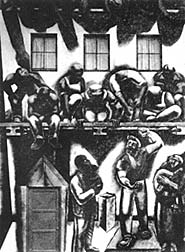Siqueiros Mural Discovery!

Worker’s Meeting (or “Mitin Obrero”), was a two-story mural painted by Mexican artist David Alfaro Siqueiros. Created on an outside wall of the Chouinard School of Art in Los Angeles, it depicted a militant union organizer addressing a multi-ethnic crowd on a LA street corner. The mural was revolutionary in more ways than one. It was the first time anyone had used an industrial spray gun to paint a mural directly on cement. Unveiled to a throng of hundreds on July 7th, 1932, the depiction of interracial unity was ahead of its time, and made the mural a target for destruction.
By the time Chouinard had closed its doors in 1972 the mural was all but forgotten. After the school folded, the building passed from hand to hand and eventually became a Korean Church. Now a startling new discovery has been made. Due to the investigations of several researchers the mural has been found intact and a possible candidate for restoration. Chouinard has re-opened in South Pasadena and is playing a key role in the hoped-for renovation.
Negotiations are underway to reacquire the old building and have its famous artwork reconstructed. Professional conservators have been brought in and they’ve found evidence of bright hues and shapes under layers of obliterating whitewash. If brought back to life the monumental work could serve as a major cultural landmark for Los Angeles and the world.
Part of “Los Tres Grandes” (the triumvirate of eminent Mexican muralists that also included Diego Rivera and José Clemente Orozco), Siqueiros visited LA as a political refugee in 1932. During his six-month stay here he painted three important murals –Worker’s Meeting, América Tropical and Portrait of Mexico Today (painted at a private residence in Pacific Palisades). These would be the only murals he would paint in the US.
The first two public artworks were marvels of innovation, employing techniques that had never been utilized before, like using camera-projections to transfer the artist’s sketches to the walls. The first two murals were also destroyed by those who could not tolerate dissenting opinions – but the fresco Portrait of Mexico Today survived because it had been created on private property (it is now part of the Santa Barbara Museum’s permanent collection).

Philip Stein (also known as Estaño), is an artist with a personal interest in seeing the LA murals restored. He worked alongside Siqueiros in Mexico for ten years, assisting the master in painting some of his most famous works. I wrote Stein and asked for his opinion regarding the Chouinard mural discovery:
“What an amazing discovery to find that the mural Worker’s Meeting or Street Meeting (Siqueiros referred to this mural often using both titles), should show signs of some degree of preservation under layers of whitewash.
Siqueiros himself was not conscious of the fact that the obliteration of the mural (as ordered by the LA Police) was done with coats of whitewash rather than total removal as he always believed. Now 73 years after it was first painted and presumed gone forever, and 31 years after Siqueiros’ death, this remarkable and historically important work holds forth promise that it may one day reappear in its full aesthetic, technical and political glory as Siqueiros had meant it to be seen.”
The works of Siqueiros have had a profound impact on me over the years. I was only a boy when I picked up an art book and saw his evocative, Echo of a Scream, a nightmarish portrait of a weeping child sitting in the rubble of a war-shattered landscape.
Being born and raised in Los Angeles I’ve spent much time on the city’s founding avenue of Olvera Street, where Siqueiros painted América Tropical. At fifteen I learned that the city had whitewashed that mural in 1932 because of its political content – which for me served as an early lesson on the power of art.
My hometown of LA will forever be linked to Siqueiros, whose works eventually helped inspire the Chicano Arts Movement of the late sixties. Today the art of Siqueiros is reaching out to us from an earlier time, and if we pay close attention we won’t find ancient relics from an irrelevant past, but a humanistic aesthetic that can be applied to the present.

